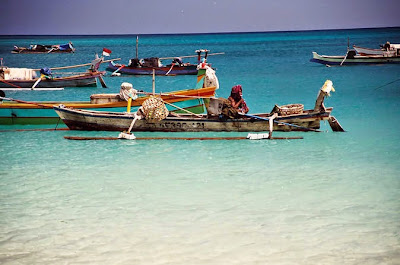Bintan is one of the islands of Riau Archipelago of Indonesia. It is
situated at about 40km from Singapore. Its capital, Tanjung Pinang is
actually the capital of Riau Archipelago. From here you can see the
importance of Bintan island.
Compared with Batam, Bintan is richer in its history. In conjunction with this background, it has more historical sites to visit.
Bintan's history is intertwined closely with those of Malacca and Johor Sultanates. Bintan and the rest of Riau Arcipelago were ruled by the Malacca Sultanate. When the Portuguese attacked Malacca in 1511, its king fled to Pahang of Malay Peninsula and later to Bintan where he tried to repossess Malacca. His successor moved to Johor and established the Johor Sultanate.
Later, the Dutch gained control of Bintan island. However, the Dutch was later driven out by a force supported by Malacca Sultanate.
In 1824, the Treaty of London finally settled that the islands south of Singapore are Dutch Territories. Again Bintan was under the control of the Dutch.
Pulau Penyengat is a must see historical site for visitors. It is situated at about 6km from Tanjung Pinang. It was the religious, cultural and administration centre of the region in 19th century. Sultan Mahmud Shah of Malacca gave this island to his bride, Raja Hamidah, daughter of Raja Ali Haji, the Bugis commander of Bintan, in an attempt to reach peace between the Malay and the Bugis. A grand mosque, Masjid Raya was built on the island. The mosque is huge and is visible from Tanjung Pinang.
Raja Ali Haji was the hero to Bintan's people. There is a monument by the seaside that commemorates him who sacrificed his life for his people against the Dutch.
Within the town of Tanjung Pinang, there is a Dutch Colonial Graveyard which reflects the life of the seamen at the old days.
Banyan Tree Temple is a popular place for the local Chinese community and Singaporean visitors. It is situated in a town called Senggarang. The temple is about 100 years old.
For holiday makers, there are broadly 2 areas for you to choose i.e. Lagoi (Bintan Resorts) at the northern part or Trikora Beach at the east of the island.
Lagoi is full of high end resorts like Banyan Tree Resort and Club Med Ria. These are exclusive resorts complete with golf courses designed by world renowned golf course designers.
Resorts and hotels at theTrikora Beach are affordable to average visitors. To name a few: Bintan Agro Beach Resorts, resorts complete with fishing facilities like Ocean Bay Resort and Kolam Kelong Trikora. There is even a resort providing diving guide i.e. Traveler Pondok Wisita. Visitors may stay in its air-conditioned or non-air-conditioned rooms overnight before diving.
Bintan is accessible from Johor Bahru and Singapore by ferry.
Article Source: http://EzineArticles.com/?expert=Chai_Yong
Compared with Batam, Bintan is richer in its history. In conjunction with this background, it has more historical sites to visit.
Bintan's history is intertwined closely with those of Malacca and Johor Sultanates. Bintan and the rest of Riau Arcipelago were ruled by the Malacca Sultanate. When the Portuguese attacked Malacca in 1511, its king fled to Pahang of Malay Peninsula and later to Bintan where he tried to repossess Malacca. His successor moved to Johor and established the Johor Sultanate.
Later, the Dutch gained control of Bintan island. However, the Dutch was later driven out by a force supported by Malacca Sultanate.
In 1824, the Treaty of London finally settled that the islands south of Singapore are Dutch Territories. Again Bintan was under the control of the Dutch.
Pulau Penyengat is a must see historical site for visitors. It is situated at about 6km from Tanjung Pinang. It was the religious, cultural and administration centre of the region in 19th century. Sultan Mahmud Shah of Malacca gave this island to his bride, Raja Hamidah, daughter of Raja Ali Haji, the Bugis commander of Bintan, in an attempt to reach peace between the Malay and the Bugis. A grand mosque, Masjid Raya was built on the island. The mosque is huge and is visible from Tanjung Pinang.
Raja Ali Haji was the hero to Bintan's people. There is a monument by the seaside that commemorates him who sacrificed his life for his people against the Dutch.
Within the town of Tanjung Pinang, there is a Dutch Colonial Graveyard which reflects the life of the seamen at the old days.
Banyan Tree Temple is a popular place for the local Chinese community and Singaporean visitors. It is situated in a town called Senggarang. The temple is about 100 years old.
For holiday makers, there are broadly 2 areas for you to choose i.e. Lagoi (Bintan Resorts) at the northern part or Trikora Beach at the east of the island.
Lagoi is full of high end resorts like Banyan Tree Resort and Club Med Ria. These are exclusive resorts complete with golf courses designed by world renowned golf course designers.
Resorts and hotels at theTrikora Beach are affordable to average visitors. To name a few: Bintan Agro Beach Resorts, resorts complete with fishing facilities like Ocean Bay Resort and Kolam Kelong Trikora. There is even a resort providing diving guide i.e. Traveler Pondok Wisita. Visitors may stay in its air-conditioned or non-air-conditioned rooms overnight before diving.
Bintan is accessible from Johor Bahru and Singapore by ferry.
Article Source: http://EzineArticles.com/?expert=Chai_Yong


















































